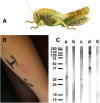Caution: Reptile pets shuttle grasshopper allergy and asthma into homes
- PMID: 26322151
- PMCID: PMC4538751
- DOI: 10.1186/s40413-015-0072-1
Caution: Reptile pets shuttle grasshopper allergy and asthma into homes
Abstract
The numbers of reptiles in homes has at least doubled in the last decade in Europe and the USA. Reptile purchases are increasingly triggered by the attempt to avoid potentially allergenic fur pets like dogs and cats. Consequently, reptiles are today regarded as surrogate pets initiating a closer relationship with the owner than ever previously observed. Reptile pets are mostly fed with insects, especially grasshoppers and/or locusts, which are sources for aggressive airborne allergens, best known from occupational insect breeder allergies. Exposure in homes thus introduces a new form of domestic allergy to grasshoppers and related insects. Accordingly, an 8-year old boy developed severe bronchial hypersensitivity and asthma within 4 months after purchase of a bearded dragon. The reptile was held in the living room and regularly fed with living grasshoppers. In the absence of a serological allergy diagnosis test, an IgE immunoblot on grasshopper extract and prick-to-prick test confirmed specific sensitization to grasshoppers. After 4 years of allergen avoidance, a single respiratory exposure was sufficient to trigger a severe asthma attack again in the patient. Based on literature review and the clinical example we conclude that reptile keeping is associated with introducing potent insect allergens into home environments. Patient interviews during diagnostic procedure should therefore by default include the question about reptile pets in homes.
Keywords: Allergy; Asthma; Grasshopper; IgE; Pets; Reptile; Reptile pets.
Figures

Similar articles
-
Early exposure to cats, dogs and farm animals and the risk of childhood asthma and allergy.Pediatr Allergy Immunol. 2020 Apr;31(3):265-272. doi: 10.1111/pai.13186. Epub 2020 Jan 11. Pediatr Allergy Immunol. 2020. PMID: 31829464
-
Early, current and past pet ownership: associations with sensitization, bronchial responsiveness and allergic symptoms in school children.Clin Exp Allergy. 2002 Mar;32(3):361-6. doi: 10.1046/j.1365-2222.2002.01254.x. Clin Exp Allergy. 2002. PMID: 11940064
-
Keeping reptiles as pets in Brazil: keepers' motivations and husbandry practices.J Ethnobiol Ethnomed. 2023 Oct 21;19(1):46. doi: 10.1186/s13002-023-00618-z. J Ethnobiol Ethnomed. 2023. PMID: 37865770 Free PMC article.
-
Respiratory sensitization to insect allergens: Species, components and clinical symptoms.Allergol Int. 2021 Jul;70(3):303-312. doi: 10.1016/j.alit.2021.04.001. Epub 2021 Apr 24. Allergol Int. 2021. PMID: 33903033 Review.
-
Early pet exposure: friend or foe?Curr Opin Allergy Clin Immunol. 2003 Feb;3(1):7-14. doi: 10.1097/00130832-200302000-00002. Curr Opin Allergy Clin Immunol. 2003. PMID: 12582308 Review.
Cited by
-
Insects and Public Health: An Overview.Insects. 2023 Feb 27;14(3):240. doi: 10.3390/insects14030240. Insects. 2023. PMID: 36975925 Free PMC article.
-
Mobile Zoos and Other Itinerant Animal Handling Events: Current Status and Recommendations for Future Policies.Animals (Basel). 2023 Jan 6;13(2):214. doi: 10.3390/ani13020214. Animals (Basel). 2023. PMID: 36670754 Free PMC article.
-
Edible Insect Farming in the Context of the EU Regulations and Marketing-An Overview.Insects. 2022 May 7;13(5):446. doi: 10.3390/insects13050446. Insects. 2022. PMID: 35621781 Free PMC article. Review.
-
Edible insects: Cross-recognition of IgE from crustacean- and house dust mite allergic patients, and reduction of allergenicity by food processing.World Allergy Organ J. 2019 Jan 26;12(1):100006. doi: 10.1016/j.waojou.2018.10.001. eCollection 2019. World Allergy Organ J. 2019. PMID: 30937131 Free PMC article.
-
Edible insects - defining knowledge gaps in biological and ethical considerations of entomophagy.Crit Rev Food Sci Nutr. 2019;59(17):2760-2771. doi: 10.1080/10408398.2018.1468731. Epub 2018 May 17. Crit Rev Food Sci Nutr. 2019. PMID: 29693413 Free PMC article. Review.
References
-
- Van Huis A, Van Itterbeeck J, Klunder H, Mertens E, Halloran A, Muir G et al. Edible insects. Future prospects for food and feed security. In: http://www.fao.org/docrep/018/i3253e/i3253e.pdf. Rome. 2013.
-
- Publication of European Union Association of Reptile Keepers (EUARK). In: http://www.fbh.org.uk/news/downloads/euark_brochure_2012.pdf. UK. 2012.
Grants and funding
LinkOut - more resources
Full Text Sources
Other Literature Sources
Miscellaneous

